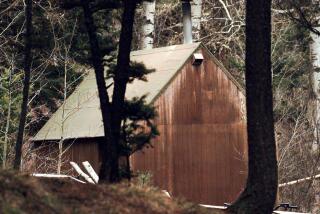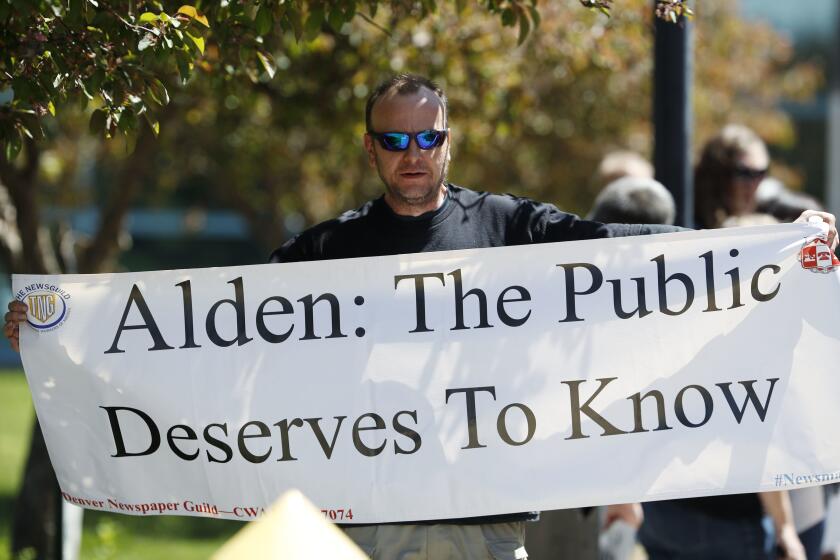The Siren’s Call: Bigfoot and secret societies
Remember Robert Bly’s bestselling 1990 book “Iron John: A Book About Men”? It was the manifesto for a movement -- a call for men to get back in touch with their primal selves. Go out in the woods, strip off your shirt, bang on a drum and howl at the moon.
Bly’s book and its cause have long been easy targets for comedians and columnists, but don’t smirk -- there was a point there. Bly drew on the Grimm brothers’ tale of Iron John/Iron Hans, a wildman in the woods who teaches a young prince some necessary lessons in order to move from childhood to maturity. Bly saw the dark woods as representing the unconscious, while the wildman hiding in it was an aspect of the male psyche that had been lost or forgotten in the modern world.
I couldn’t stop thinking of that as I read ” Bigfoot: The Life and Times of a Legend” ( University of Chicago: 280 pp., $29) because it’s a viewpoint that author Joshua Blu Buhs essentially shares. Whether or not there’s really a furry, humanoid-like creature out there, he says, our obsession with finding him stems from a psychological need -- we want to believe there’s a beast in the woods, waiting to be found.
That view’s certainly going to irritate the Bigfooters.
There are very serious ones out there. When you get past all the spoof material on the Web -- and there is plenty -- you come across proprietors like Bobbie Short, whose site Bigfoot Encounters aims to debunk skeptics and serve as a place to report sightings. The Blogsquatcheralso solicits reports of sightings, as well as offering a miscellany of posts about fear pheromones, hoaxes, hunter experiences and Bigfoot “vocalizations.”
While the Bigfooters are intent on the proof of Bigfoot’s existence, Buhs asserts that the only thing we can absolutely confirm about him is this: Our interest is a sign of our unquenchable fascination for mysteries. Our collective mind set has been primed by centuries of “stories about wildmen” -- these include reports by Marco Polo and other early explorers, fantastic bestiaries, P.T. Barnum’s What-Is-It and the Brothers Grimm -- so that Bigfoot’s “arrival” in the mid-20th century is just the latest in a long parade of curious figures:
As Buhs writes: “The ancient Greeks’ fervid imaginations populated the earth with all sorts of wildmen and wildwomen: Amazons and centaurs and cyclopes and fauns and giants and maenads and satyrs and sileni and titans. . . . Throughout history, stories about wildmen have provided a way of thinking about what it means to be human . . . “
Michael McLeod takes a similar tack in “Anatomy of a Beast: Obsession and Myth on the Trail of Bigfoot” ( University of California: 224 pp., $24.95), considering Bigfoot more as a cultural manifestation than a hairy reality. “Bigfoot is more than just a silly slice of history,” McLeod says. “The beast’s appearance on the national scene marked an important milestone: the first widely popularized example of pseudoscience in American culture.”
“Pseudoscience” may hit the Bigfooters especially hard -- but McLeod and Buhs use this term only to point out how devilishly difficult it has been for the scientific community to investigate the phenomenon. Buhs begins his book with the discovery of tracks on Mt. Everest in 1951 said to be made by a red-haired being called the Yeti and Sir Edmund Hillary’s expedition to find evidence (unsuccessful). He also turns to the search, in Canada, for a related creature called the Sasquatch. Much of McLeod’s narrative also describes the intense efforts by professional searchers to encounter a creature that hapless hikers have never seemed to have any trouble finding. He also looks at the continuing debate over the late Roger Patterson’s famous 1967 film footage. You know what this shows -- a large creature looks back as it lumbers across a dry riverbed in Bluff Creek, Calif.
Though a variety of players overlap in these two books, each has its own particular strengths. Buhs, for instance, does an excellent job of showing how Bigfoot was readily embraced by the growing industry of pulp fantasy stories and men’s magazines in the 1950s and 1960s. Bigfoot, he explains, fueled our male fantasies of adventure (shades of Bly). One of the best sections in McLeod’s book is about a vast area -- first described by David Rains Wallace in his book “The Klamath Knot” -- covering the California- Oregon border and including Six Rivers National Forest (which encompasses Bluff Creek, by the way) and Klamath National Forest. This entire region is regarded as the “Galapagos of North America”:
“The Klamath ecosystem is home to 281 species found nowhere else, including the Siskiyou Mountain salamander, Brewer’s spruce, and . . . a flowering plant endemic to the Siskiyou mountain, which once grew on an island in the Pacific Ocean. . . . Bigfoot is not the only mystery here. Some lakes in the Trinity Alps are said to contain giant salamanders, called belly-whompers . . . a giant lizardlike creature measuring eight feet, four inches long. . . .”
A large upright creature, then, wouldn’t seem so out of place here. McLeod’s portrait of this primeval world is engrossing.
In the course of reading both books, I still wondered about the same thing that novices have always wondered about: How could such a big creature be so skillful at avoiding a good photograph? With the exception of Patterson’s film footage, most of the imagery you find on the web is pretty awful. Our age is so overexposed, so camera-prone -- can’t somebody get a decent photo? Should we ask TMZ.com to take a crack at it?
As if in reply, Buhs provides Bigfooters with an unexpected defense:
“Science deals with many entities that have never been observed directly. No one has seen a black hole. No one has seen a boson. These things are known by their effects, by the traces that they leave: by bending light, by tracks left in particle detectors.”
Bosons, black holes and Bigfoot -- that’s one way of looking at this subject.
Or else you might add another “b” -- for Bly -- and simply appreciate the symbolism resonating in this search.
PSEUDOSCIENCE AND THE ROLE of real scientific inquiry in public discussions -- these are the focus of “Unscientific America: How Scientific Illiteracy Threatens Our Future” by Chris Mooney and Sheril Kirshenbaum. This week, my colleague Lori Kozlowski’s interview with Mooney drew a deluge of angry responses from readers. Mooney and Kirshenbaum write in their book about how anti-intellectualism leads the public to reject science in favor of unconfirmed theories of how things work. Often, this kind of rejection comes with a firm belief that conspiracies and hidden agendas are preventing the truth from being revealed.
Fears of conspiracies and mysterious cabals are nothing new -- that’s what Arthur Goldwag illustrates in “Cults, Conspiracies and Secret Societies” (Vintage Books: $16 paper). The book is part compendium/part commentary on the numerous organizations and practices which strike fear in people’s hearts. Goldwag does more than cover territory popularized by Dan Brown -- though Opus Dei, the Templars, Illuminati and Freemasons are here. He also ranges far and wide to discuss the Hermetic Order of the Golden Dawn, for instance, alongside the Jesuits -- and Al Qaeda (?). The key to these groups is that they all depend, to some degree, on secrecy and initiation as a means of maintaining exclusivity. In a section titled “The Conspiratorial Frame of Mind,” Goldwag describes conspiracies in ancient Rome, the aura of mystery around the Freemasons, 9/11 theories, plots alleged to be the work of Jews (they’ve been blamed for just about everything, including the JFK assassination, the death of Princess Di and centuries of global unrest) and the appeal of places like Area 51 in the Nevada desert. “Our susceptibility to conspiratorial thinking is literally hardwired in our brains,” Goldwag writes. He cites experiments at the University of Texas, Austin, and Northwestern University that explain why we’re so conspiratorially inclined: “[T]he less control people have over their lives, the more likely they are to try and regain control through mental gymnastics.”
ONE FINAL NOTE, on an entirely different topic: Solomon Kane (I know, yet again). In the 1970s, Robert E. Howard’s stories of the Puritan swordsman were turned into short comic adventures appearing in a variety of places, including Monsters Unleashed, Kull and the Barbarians and the Savage Sword of Conan. Dark Horse has collected these as “The Saga of Solomon Kane” (Dark Horse: 410 pp., $19.95 paper), and all I can say is, ugh.
The comic versions are disappointing to me partly because they give Kane too much sex appeal: He wears his Puritan garb more like Errol Flynn or Conan in civilizing clothes than like the dour, elusive force of vengeance Howard intended him to be. Then, there are the monsters. The horror imagery in Howard -- often intentionally diffuse, a little obscure -- enables each reader to imagine his own particular phantoms. Howard is brilliant at bringing each person’s own fears into play in his stories, but there’s no room for that in these comics. The misty monster, for example, that haunts the barren road to Torkertown in “Skulls in the Stars” looks absolutely ridiculous. Instead of an elusive predator, it looks like some giant, fanged, grinning Pokemon.
Where comics interpretation of Howard is concerned, check out the graphic novel “The Castle of the Devil” (Dark Horse: 142 pp., $15.95 paper), which collects the more recent series by Scott Allie, Mario Guevara with Dave Stewart. They’ve included a new short Kane tale here, “The Nightcomers,” that captures -- in just a few panels -- the ominous atmosphere and particular doom of a lonely town. Kane, in discovering this town’s problem, realizes -- as we all do -- that nothing is ever what it at first appears to be.
Owchar is deputy books editor. “The Siren’s Call” appears twice a month at latimes.com/books.
More to Read
The biggest entertainment stories
Get our big stories about Hollywood, film, television, music, arts, culture and more right in your inbox as soon as they publish.
You may occasionally receive promotional content from the Los Angeles Times.










